Numerical Simulation of MHD Natural Convection and Entropy Generation in Semicircular Cavity Based on LBM
Abstract
:1. Introduction
2. Methods
2.1. Problem Statement
2.2. Governing Equation
| Coefficient | CuO-H2O |
|---|---|
| −26.593310846 | |
| −0.403818333 | |
| −33.3516805 | |
| −1.915825591 | |
| 6.42185846658 × 10−2 | |
| 48.40336955 | |
| −9.787756683 | |
| 190.245610009 | |
| 10.9285386565 | |
| −0.72009983664 |
2.3. Lattice Boltzmann Equation
2.4. LBM Boundary Condition
2.5. Average Nusselt Number
2.6. Entropy Generation
3. Results and Discussion
3.1. Model Validation
3.2. Grid Independence Verification
3.3. Influence of Ra and Ha on Flow
3.4. Average Nusselt Number of Heat Source Surface
3.4.1. Influence of Ra and Ha on the Average Nusselt Number
3.4.2. Influence of Magnetic Field Angle and Ha on the Average Nusselt Number
3.5. Total Entropy Generation and Bejan Number
3.5.1. Generation of Entropy
3.5.2. Bejan Number
4. Conclusions
- For either Case 1 or Case 2, the increase in Ra makes the isotherm more pinnate and distorted, and the increase in Ha inhibits it. The maximum value of the flow function increases with the increase in Ra and the decrease in Ha. Compared with Case 1 and Case 2, the flow function of Case 2 is larger under the same conditions.
- When Ha ≥ 30, the decreases first and then increases sharply with the Rayleigh number. When Ra = 105 and Ha = 30, the reaches the maximum value when . The average Nusselt number of Case 1 is larger than that of Case 2 under the same conditions, and the heat transfer effect of Case 2 is better.
- Under the same Ha, the increase in Ra can promote the increase in , when and Ha < 30, is the increasing function of Ha. When Ha = 30, reaches the maximum. With the continuous increase in Ha, is the decreasing function of Ha. Changing the angle of the magnetic field can affect this trend, when and , reaches its maximum when Ha = 40. Under the same conditions, in Case 2 is higher than that in Case 1.
Author Contributions
Funding
Data Availability Statement
Conflicts of Interest
Nomenclature
| B | Magnetic induction intensity (T) | x(x,y) | Lattice coordinates (m) |
| B | Width of heat source () | Thermal diffusivity coefficient (m2 s−1) | |
| Be | Bejan number | Thermal expansion coefficient (K−1) | |
| C | Lattice sound speed | Magnetic field inclination angle | |
| ci | The discrete direction vector | Discrete time step | |
| Lattice sound speed of the D2Q9 model | Lattice space | ||
| Cp | Specific heat capacity (J kg−1K−1) | Nondimensional temperature (T/Tc)/(Th/Tc) | |
| D | The diameter of a semicircle (m) | kinematic viscosity (m2 s−1) | |
| D | Diameter (m) | Dynamic viscosity (kg m−1 s−1) | |
| F | External force term | Macroscopic density of fluid (kg m−3) | |
| F | Equilibrium density distribution functions (kg m−3) | Electrical conductivity (S m−1) | |
| g | Equilibrium internal energy distribution functions (K) | Viscous/thermal relaxation time | |
| g | Gravitational acceleration (m s−2) | Nanoparticle volume fraction | |
| Ha | Hartmann number () | Irreversibility factor | |
| k | Thermal conductivity (W m−1 K−1) | Stream function | |
| kb | Boltzmann constant | i | Weight coefficient |
| N | Grid size | Subscripts | |
| Nu | The Nusselt number | ave | Average |
| Pr | Prandtl number () | eq | equilibrium |
| Ra | Rayleigh number () | f | Base fluid |
| Nondimensional entropy Generation due to heat transfer | h,c | Hot, cold | |
| Nondimensional entropy generation due to fluid friction | i | Lattice direction | |
| Nondimensional entropy generation due to magnetic field | m | Mean | |
| T | Temperature (K) | nf | Nanofluid phase |
| U[U,V] | Dimensionless velocity () | p | nanoparticles |
| u | Lattice speed | * | dimensional quantity |
| u[u,v] | Macroscopic velocity (m s−1) |
References
- Samipour, S.A.; Khaliulin, V.I.; Batrakov, V.V. Development of the Technology of Manufacturing Aerospace Composite Tubular Elements by Radial Braiding. J. Mach. Manuf. Reliab. 2018, 47, 284–289. [Google Scholar] [CrossRef]
- Wang, Z.L. Triboelectric Nanogenerators as New Energy Technology for Self-Powered Systems and as Active Mechanical and Chemical Sensors. ACS Nano 2013, 7, 9533–9557. [Google Scholar] [CrossRef]
- Choi, S.U.S.; Eastman, J. Enhancing Thermal Conductivity of Fluids with Nanoparticles. In Proceedings of the 1995 International Mechanical Engineering Congress and Exhibition, San Francisco, CA, USA, 12–17 November 1995; Volume 66. [Google Scholar]
- Meghdadi Isfahani, A.H.; Afrand, M. Experiment and Lattice Boltzmann numerical study on nanofluids flow in a micromodel as porous medium. Phys. E Low-Dimens. Syst. Nanostruct. 2017, 94, 15–21. [Google Scholar] [CrossRef]
- Manna, O.; Singh, S.K.; Paul, G. Enhanced thermal conductivity of nano-SiC dispersed water based nanofluid. Bull Mater. Sci. 2012, 35, 707–712. [Google Scholar] [CrossRef]
- Chang, H.; Jwo, C.S.; Fan, P.S.; Pai, S.H. Process optimization and material properties for nanofluid manufacturing. Int. J. Adv. Manuf. Technol. 2007, 34, 300–306. [Google Scholar] [CrossRef]
- Sheikholeslami, M.; Gorji-Bandpy, M.; Seyyedi, S.M.; Ganji, D.D.; Rokni, H.B.; Soleimani, S. Application of LBM in simulation of natural convection in a nanofluid filled square cavity with curve boundaries. Powder Technol. 2013, 247, 87–94. [Google Scholar] [CrossRef]
- Ghasemi, B.; Aminossadati, S.M.; Raisi, A. Magnetic field effect on natural convection in a nanofluid-filled square enclosure. Int. J. Therm. Sci. 2011, 50, 1748–1756. [Google Scholar] [CrossRef]
- Nakharintr, L.; Naphon, P. Magnetic field effect on the enhancement of nanofluids heat transfer of a confined jet impingement in mini-channel heat sink. Int. J. Heat Mass Tran. 2017, 110, 753–759. [Google Scholar] [CrossRef]
- Lee, T.; Lee, J.H.; Jeong, Y.H. Flow boiling critical heat flux characteristics of magnetic nanofluid at atmospheric pressure and low mass flux conditions. Int. J. Heat Mass Tran. 2013, 56, 101–106. [Google Scholar] [CrossRef]
- Balakin, B.V.; Stava, M.; Kosinska, A. Photothermal convection of a magnetic nanofluid in a direct absorption solar collector. Sol. Energy 2022, 239, 33–39. [Google Scholar] [CrossRef]
- Khanafer, K.; Vafai, K.; Lightstone, M. Buoyancy-driven heat transfer enhancement in a two-dimensional enclosure utilizing nanofluids. Int. J. Heat Mass Tran. 2003, 46, 3639–3653. [Google Scholar] [CrossRef]
- Mahmoodi, M. Numerical simulation of free convection of a nanofluid in L-shaped cavities. Int. J. Therm. Sci. 2011, 50, 1731–1740. [Google Scholar] [CrossRef]
- Sourtiji, E.; Hosseinizadeh, S.F. Heat transfer augmentation of magnetohydrodynamics natural convection in L-shaped cavities utilizing nanofluids. Therm. Sci. 2012, 16, 489–501. [Google Scholar] [CrossRef]
- He, B.; Lu, S.; Gao, D.; Chen, W.; Li, X. Lattice Boltzmann simulation of double diffusive natural convection of nanofluids in an enclosure with heat conducting partitions and sinusoidal boundary conditions. Int. J. Mech. Sci. 2019, 161, 105003. [Google Scholar] [CrossRef]
- Saberi, A.H.; Kalteh, M. Two-phase lattice Boltzmann simulation of nanofluid conjugate heat transfer in a microchannel. Thermophys. Aeromech. 2021, 28, 401–419. [Google Scholar] [CrossRef]
- Alinejad, J.; Esfahani, J.A. Lattice Boltzmann simulation of 3-dimensional natural convection heat transfer of CuO/water nanofluids. Thermophys. Aeromech. 2017, 24, 95–108. [Google Scholar] [CrossRef]
- Goodarzi, M.; Orazio, A.D.; Keshavarzi, A.; Mousavi, S.; Karimipour, A. Develop the nano scale method of lattice Boltzmann to predict the fluid flow and heat transfer of air in the inclined lid driven cavity with a large heat source inside, Two case studies: Pure natural convection & mixed convection. Phys. A Stat. Mech. Its Appl. 2018, 509, 210–233. [Google Scholar]
- Ma, Y.; Rashidi, M.M.; Mohebbi, R.; Yang, Z.G. Nanofluid natural convection in a corrugated solar power plant using the hybrid LBM-TVD method. Energy 2020, 199, 117402. [Google Scholar] [CrossRef]
- Li, J. Computational Analysis of Nanofluid Flow in Microchannels with Applications to Micro-Heat Sinks and Bio-MEMS. Ph.D. Thesis, North Carolina State University, Raleigh, NC, USA, 2008. [Google Scholar]
- Sheikholeslami, M.; Gorji-Bandpy, M.; Ganji, D.D.; Soleimani, S. Natural convection heat transfer in a cavity with sinusoidal wall filled with CuO–water nanofluid in presence of magnetic field. J. Taiwan Inst. Chem. E 2014, 45, 40–49. [Google Scholar] [CrossRef]
- Koo, J. Computational Nanofluid Flow and Heat Transfer Analyses Applied to Micro-Systems. Ph.D. Thesis, North Carolina State University, Raleigh, NC, USA, 2005. [Google Scholar]
- Koo, J.; Kleinstreuer, C. A new thermal conductivity model for nanofluids. J. Nanopart. Res. 2004, 6, 577–588. [Google Scholar] [CrossRef]
- Pordanjani, A.H.; Jahanbakhshi, A.; Nadooshan, A.A.; Afrand, M. Effect of two isothermal obstacles on the natural convection of nanofluid in the presence of magnetic field inside an enclosure with sinusoidal wall temperature distribution. Int. J. Heat Mass Tran. 2018, 121, 565–578. [Google Scholar] [CrossRef]
- Koo, J.; Kleinstreuer, C. Laminar nanofluid flow in microheat-sinks. Int. J. Heat Mass Tranf. 2005, 48, 2652–2661. [Google Scholar] [CrossRef]
- Guo, Z.; Shi, B.; Zheng, C. A coupled lattice BGK model for the Boussinesq equations. Int. J. Numer. Meth. Fluidsuids 2002, 39, 325–342. [Google Scholar] [CrossRef]
- Qian, Y.H.; D’Humières, D.; Lallemand, P. Lattice BGK Models for Navier-Stokes Equation. Europhys. Lett. 1992, 17, 479. [Google Scholar] [CrossRef]
- Tao, S.; Wang, L.; Ge, Y.; He, Q. Application of half-way approach to discrete unified gas kinetic scheme for simulating pore-scale porous media flows. Comput. Fluids 2021, 214, 104776. [Google Scholar] [CrossRef]
- Basak, T.; Kaluri, R.S.; Balakrishnan, A.R. Entropy Generation During Natural Convection in a Porous Cavity: Effect of Thermal Boundary Conditions. Numer. Heat Transf. Part A Appl. 2012, 62, 336–364. [Google Scholar] [CrossRef]
- De Vahl Davis, G. Natural convection of air in a square cavity: A bench mark numerical solution. Int. J. Numer. Meth. Fluids 1983, 3, 249–264. [Google Scholar] [CrossRef]
- Gawas, A.S.; Patil, D.V. Rayleigh-Bénard type natural convection heat transfer in two-dimensional geometries. Appl. Therm. Eng. 2019, 153, 543–555. [Google Scholar] [CrossRef]
- Magherbi, M.; Abbassi, H.; Brahim, A.B. Entropy generation at the onset of natural convection. Int. J. Heat Mass Transf. 2003, 46, 3441–3450. [Google Scholar] [CrossRef]
- Kashyap, D.; Dass, A.K. Effect of boundary conditions on heat transfer and entropy generation during two-phase mixed convection hybrid Al2O3-Cu/water nanofluid flow in a cavity—ScienceDirect. Int. J. Mech. Sci. 2019, 157, 45–59. [Google Scholar] [CrossRef]
- Kim, B.S.; Lee, D.S.; Ha, M.Y.; Yoon, H.S. A numerical study of natural convection in a square enclosure with a circular cylinder at different vertical locations. Int. J. Heat Mass Transf. 2008, 51, 1888–1906. [Google Scholar] [CrossRef]
- Warrington, R.O.; Powe, R.E. The transfer of heat by natural convection between bodies and their enclosures. Int. J. Heat Mass Tran. 1985, 28, 319–330. [Google Scholar] [CrossRef]

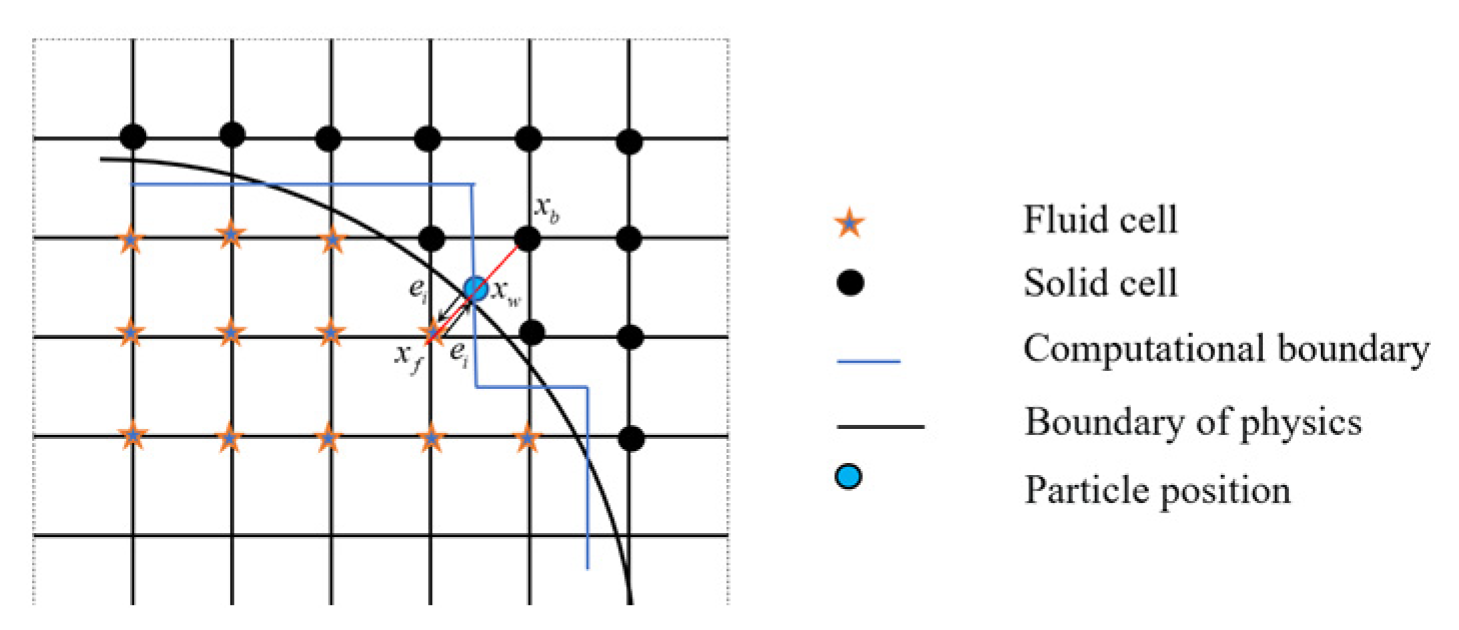
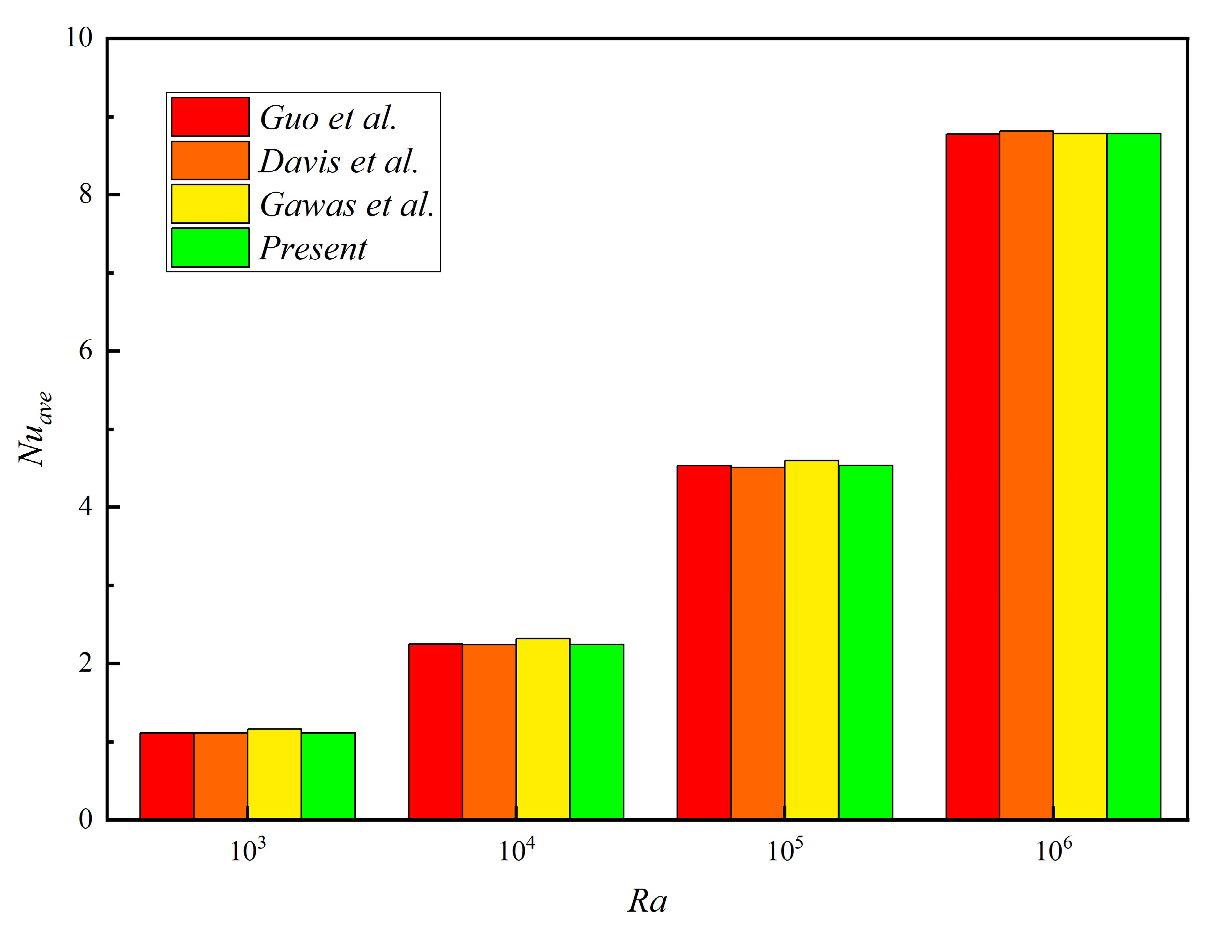

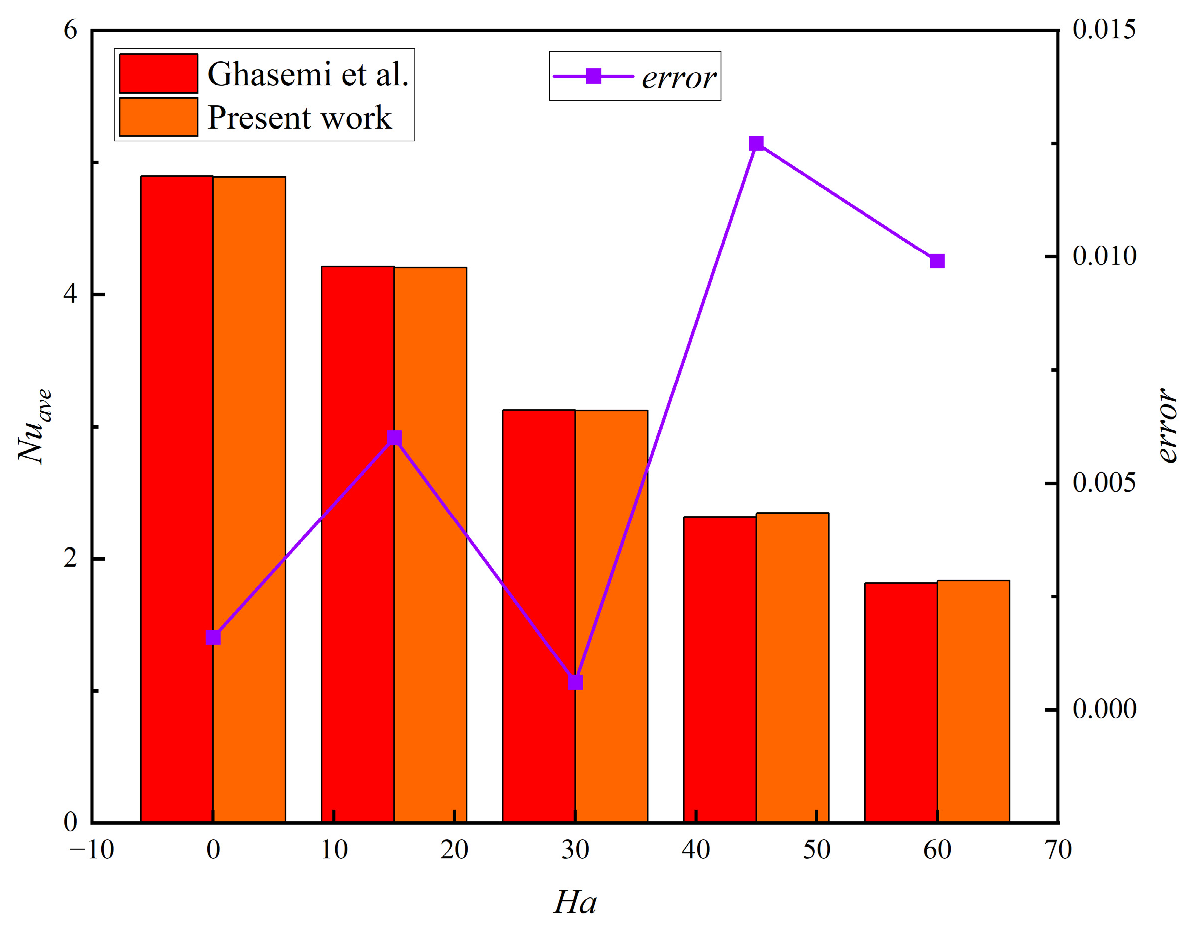
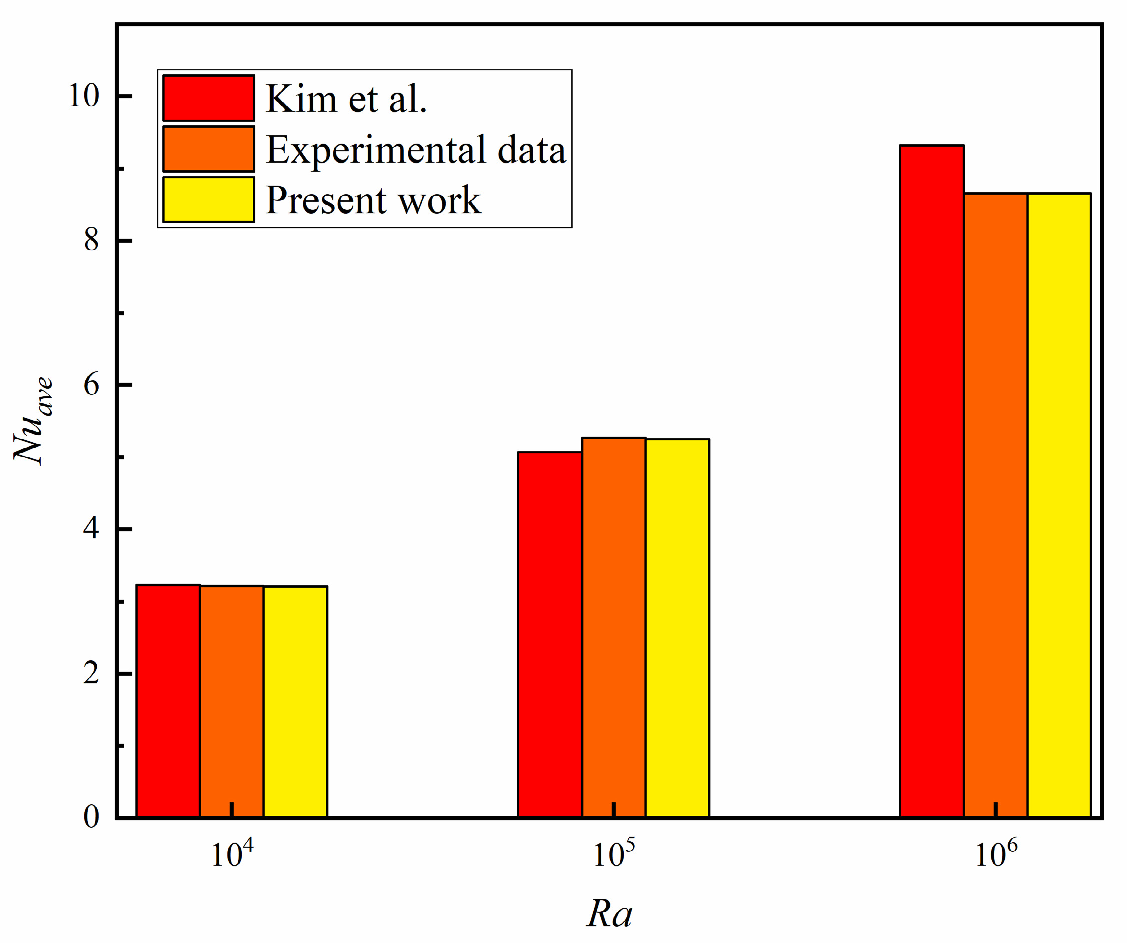

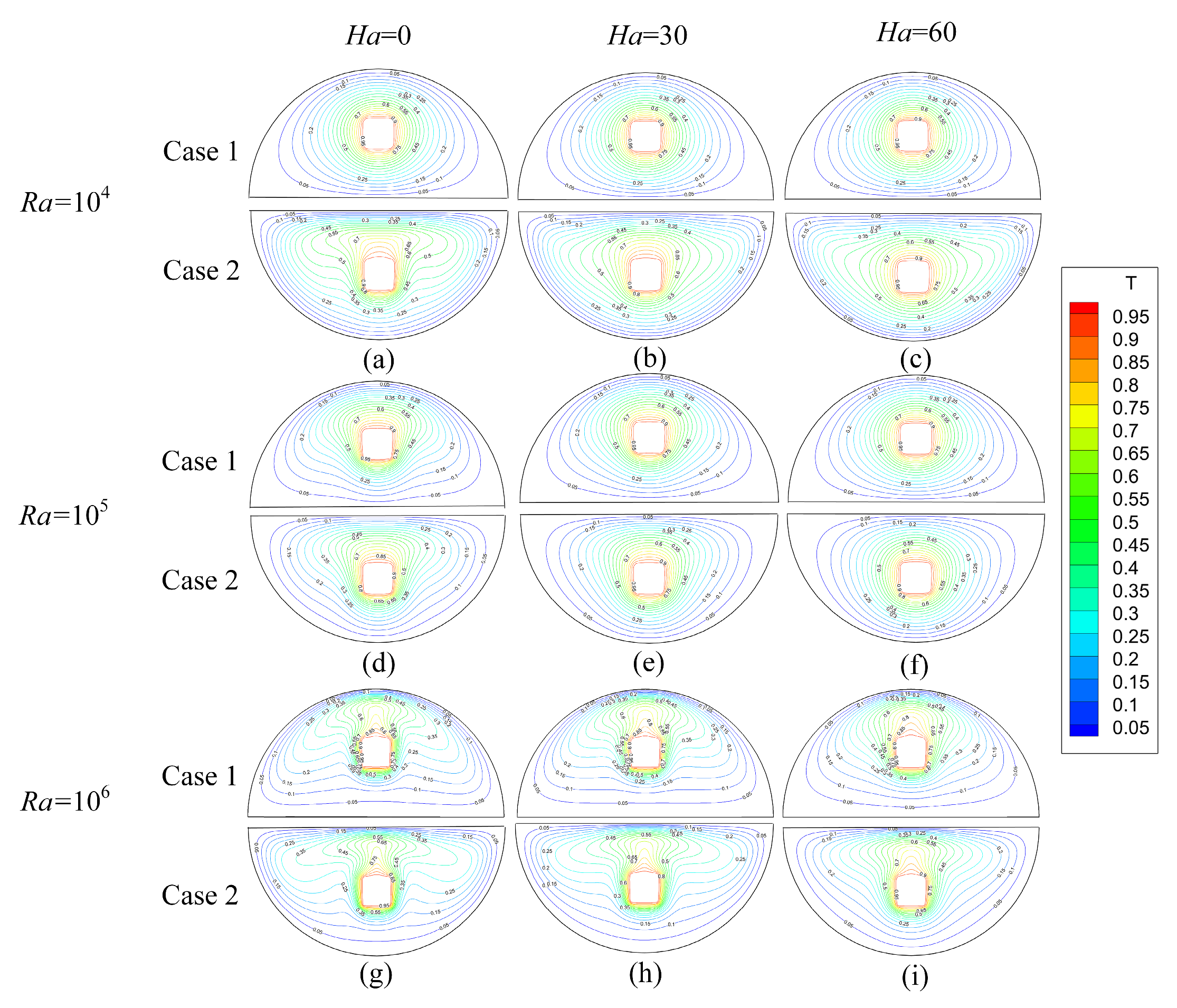

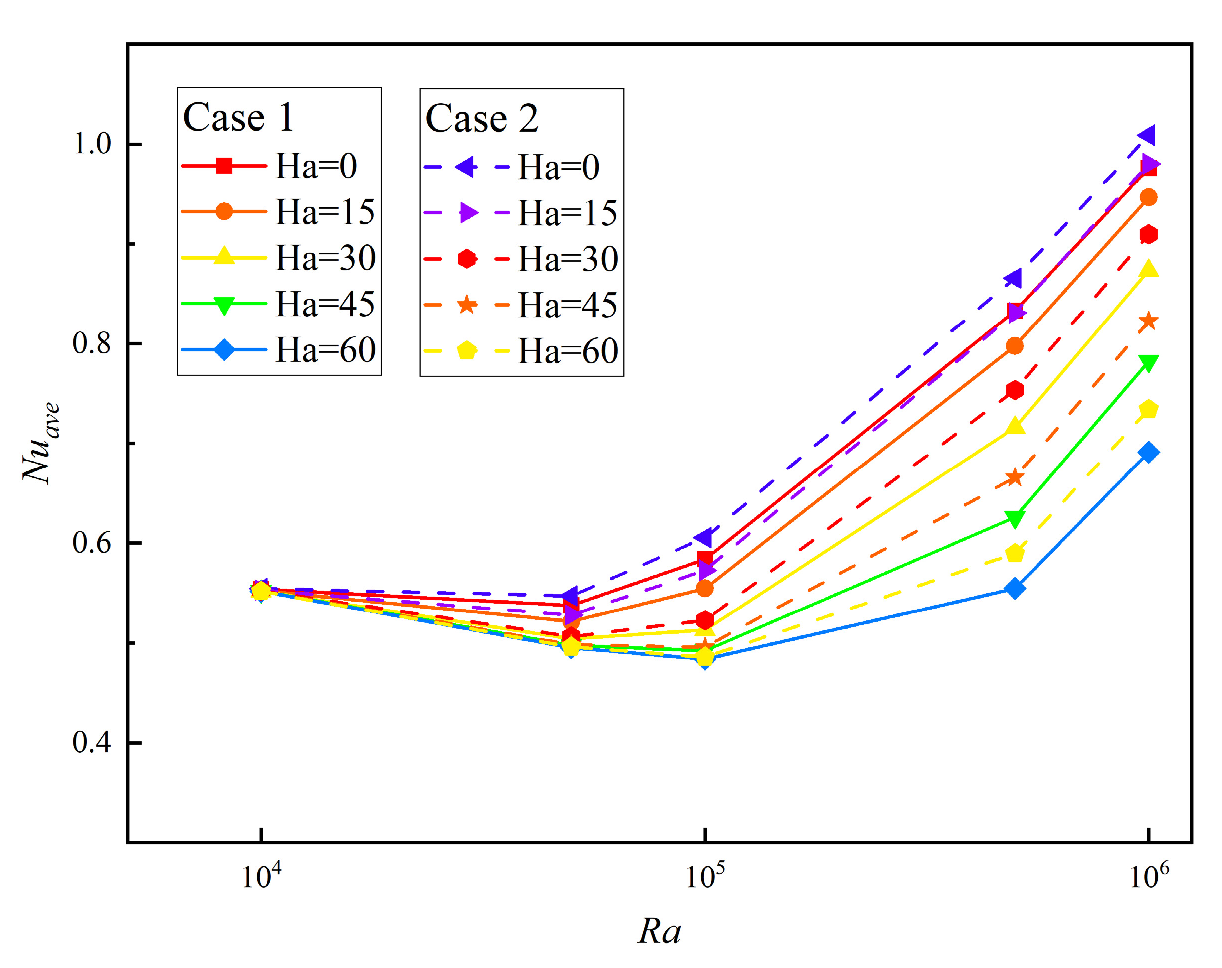

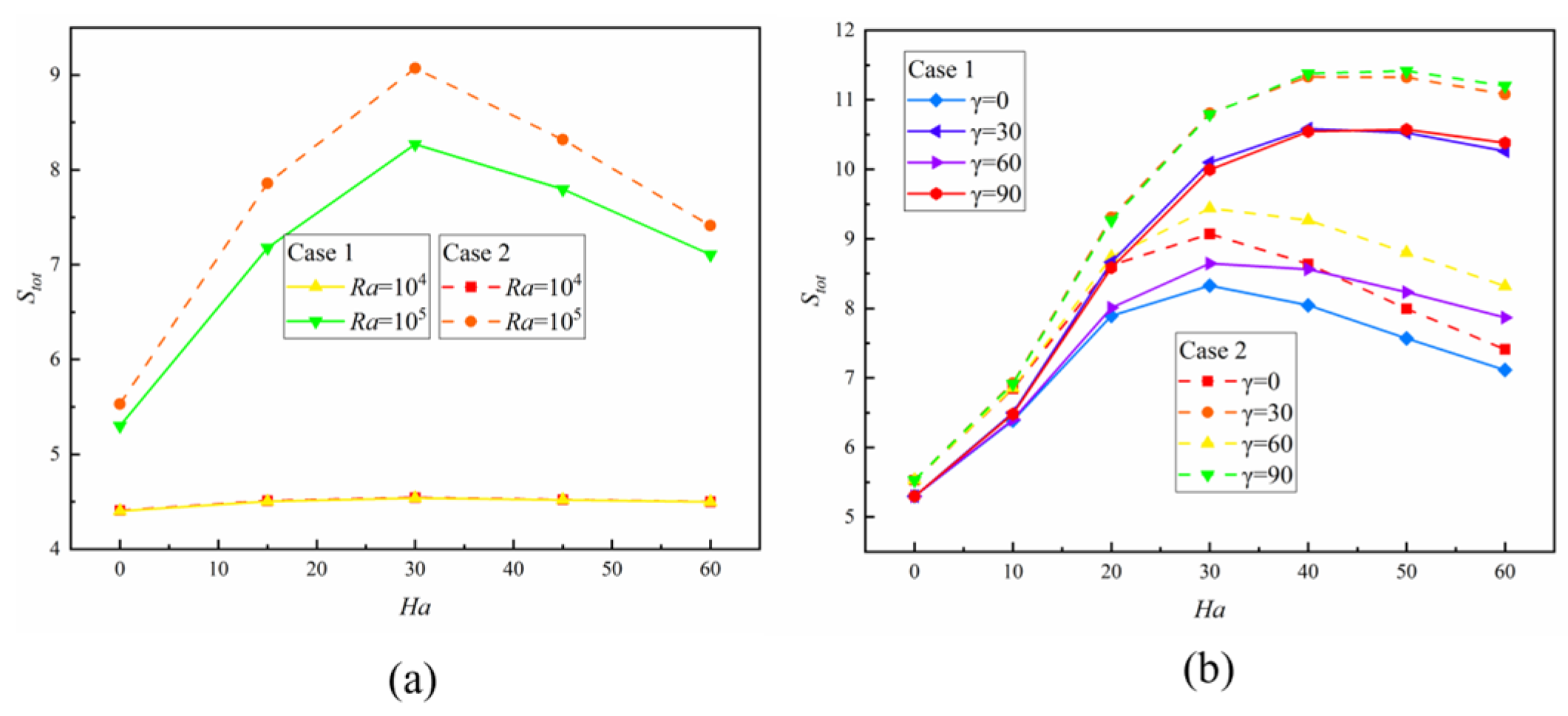
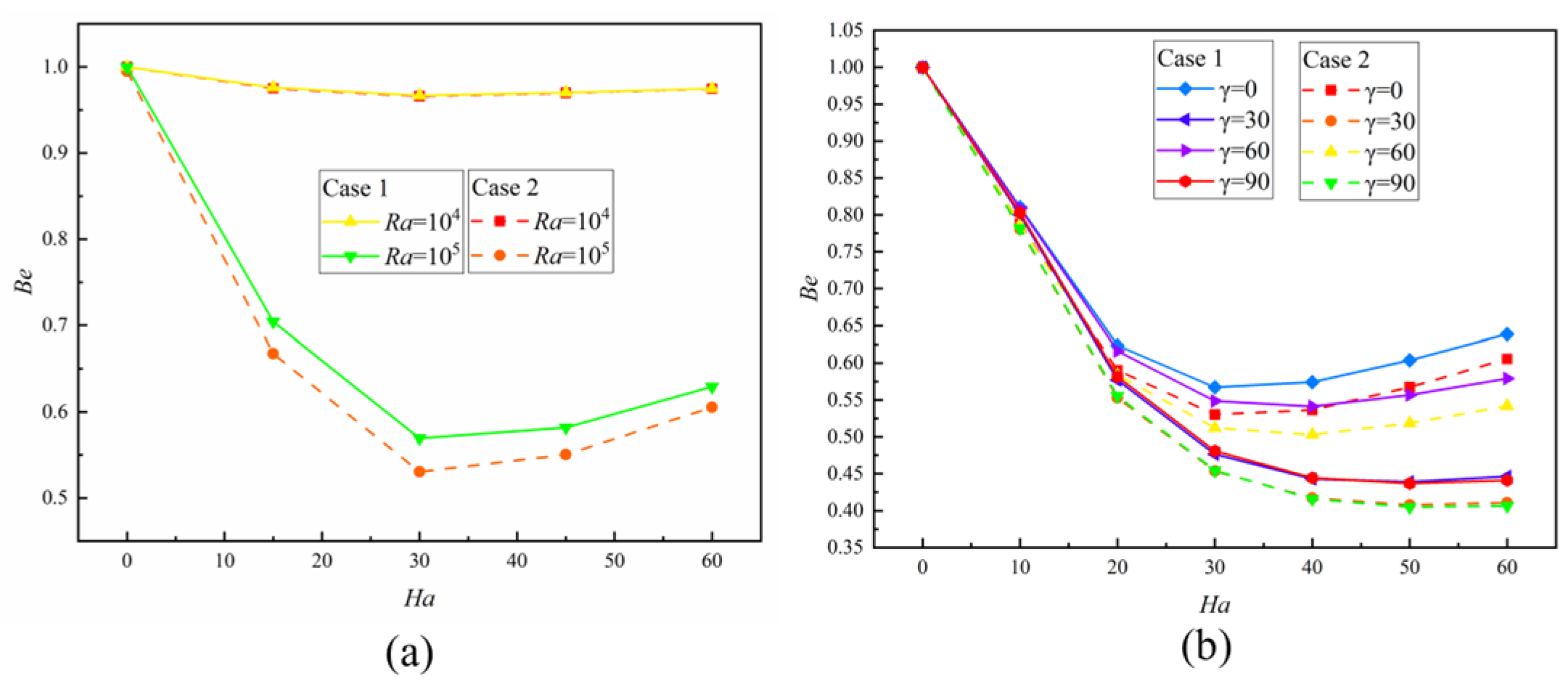
| Physical Property | Pure Water | CuO |
|---|---|---|
| 997.1 | 6500 | |
| 4179 | 540 | |
| 0.613 | 18 | |
| - | 29 | |
| 0.05 |
Disclaimer/Publisher’s Note: The statements, opinions and data contained in all publications are solely those of the individual author(s) and contributor(s) and not of MDPI and/or the editor(s). MDPI and/or the editor(s) disclaim responsibility for any injury to people or property resulting from any ideas, methods, instructions or products referred to in the content. |
© 2023 by the authors. Licensee MDPI, Basel, Switzerland. This article is an open access article distributed under the terms and conditions of the Creative Commons Attribution (CC BY) license (https://creativecommons.org/licenses/by/4.0/).
Share and Cite
Yuan, Z.; Dong, Y.; Jin, Z. Numerical Simulation of MHD Natural Convection and Entropy Generation in Semicircular Cavity Based on LBM. Energies 2023, 16, 4055. https://doi.org/10.3390/en16104055
Yuan Z, Dong Y, Jin Z. Numerical Simulation of MHD Natural Convection and Entropy Generation in Semicircular Cavity Based on LBM. Energies. 2023; 16(10):4055. https://doi.org/10.3390/en16104055
Chicago/Turabian StyleYuan, Zihao, Yinkuan Dong, and Zunlong Jin. 2023. "Numerical Simulation of MHD Natural Convection and Entropy Generation in Semicircular Cavity Based on LBM" Energies 16, no. 10: 4055. https://doi.org/10.3390/en16104055
APA StyleYuan, Z., Dong, Y., & Jin, Z. (2023). Numerical Simulation of MHD Natural Convection and Entropy Generation in Semicircular Cavity Based on LBM. Energies, 16(10), 4055. https://doi.org/10.3390/en16104055






